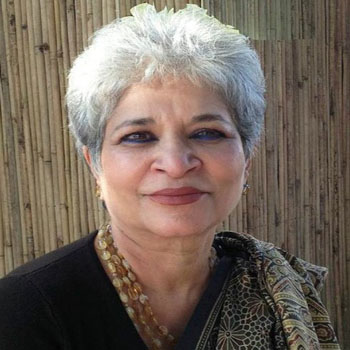
The Textile Man Who Understood Both Tradition and Technique
Tyabji, Laila
September, 2023
A long-time friend writes about Martand Singh's drive and commitment to document Indian textiles and reveal them to the world.
[caption id="attachment_198237" align="aligncenter" width="398"] Martand Singh in his spiritual home of Varanasi. Credit: A.G. Krishna Menon[/caption]
In a curious coincidence, the night the Hall of Nations building at Pragati Maidan was bulldozed and demolished by a government order, also saw the premature passing of Martand Singh at the age of 70, who, as a young designer had been part of the creation of Pragati Maidan in 1972.
Singh, affectionately known as Mapu, went on to become one of India’s premier textile authorities. His exhibitions and redesign of Indian textiles in the 1980s and 90s looked afresh at our increasingly static textile traditions and gave them a new dynamic. His inspired and guided four decades of craftspeople, designers, researchers and students of handloom. Mapu himself, and his and Raj Rewal’s iconic building were both an important part of post-independent India’s cultural heritage. Now, both are irretrievably gone forever; it is important to remember what they stood for.
Mapu was one of those Renaissance figures, now rapidly disappearing as narrowly specialised so-called “experts” take their place. People like him are irreplaceable because they un...
Martand Singh in his spiritual home of Varanasi. Credit: A.G. Krishna Menon[/caption]
In a curious coincidence, the night the Hall of Nations building at Pragati Maidan was bulldozed and demolished by a government order, also saw the premature passing of Martand Singh at the age of 70, who, as a young designer had been part of the creation of Pragati Maidan in 1972.
Singh, affectionately known as Mapu, went on to become one of India’s premier textile authorities. His exhibitions and redesign of Indian textiles in the 1980s and 90s looked afresh at our increasingly static textile traditions and gave them a new dynamic. His inspired and guided four decades of craftspeople, designers, researchers and students of handloom. Mapu himself, and his and Raj Rewal’s iconic building were both an important part of post-independent India’s cultural heritage. Now, both are irretrievably gone forever; it is important to remember what they stood for.
Mapu was one of those Renaissance figures, now rapidly disappearing as narrowly specialised so-called “experts” take their place. People like him are irreplaceable because they un...
 Martand Singh in his spiritual home of Varanasi. Credit: A.G. Krishna Menon[/caption]
In a curious coincidence, the night the Hall of Nations building at Pragati Maidan was bulldozed and demolished by a government order, also saw the premature passing of Martand Singh at the age of 70, who, as a young designer had been part of the creation of Pragati Maidan in 1972.
Singh, affectionately known as Mapu, went on to become one of India’s premier textile authorities. His exhibitions and redesign of Indian textiles in the 1980s and 90s looked afresh at our increasingly static textile traditions and gave them a new dynamic. His inspired and guided four decades of craftspeople, designers, researchers and students of handloom. Mapu himself, and his and Raj Rewal’s iconic building were both an important part of post-independent India’s cultural heritage. Now, both are irretrievably gone forever; it is important to remember what they stood for.
Mapu was one of those Renaissance figures, now rapidly disappearing as narrowly specialised so-called “experts” take their place. People like him are irreplaceable because they un...
Martand Singh in his spiritual home of Varanasi. Credit: A.G. Krishna Menon[/caption]
In a curious coincidence, the night the Hall of Nations building at Pragati Maidan was bulldozed and demolished by a government order, also saw the premature passing of Martand Singh at the age of 70, who, as a young designer had been part of the creation of Pragati Maidan in 1972.
Singh, affectionately known as Mapu, went on to become one of India’s premier textile authorities. His exhibitions and redesign of Indian textiles in the 1980s and 90s looked afresh at our increasingly static textile traditions and gave them a new dynamic. His inspired and guided four decades of craftspeople, designers, researchers and students of handloom. Mapu himself, and his and Raj Rewal’s iconic building were both an important part of post-independent India’s cultural heritage. Now, both are irretrievably gone forever; it is important to remember what they stood for.
Mapu was one of those Renaissance figures, now rapidly disappearing as narrowly specialised so-called “experts” take their place. People like him are irreplaceable because they un...
This is a preview. To access all the essays on the Global InCH Journal a modest subscription cost is being levied to cover costs of hosting, editing, peer reviewing etc. To subscribe, Click Here.



